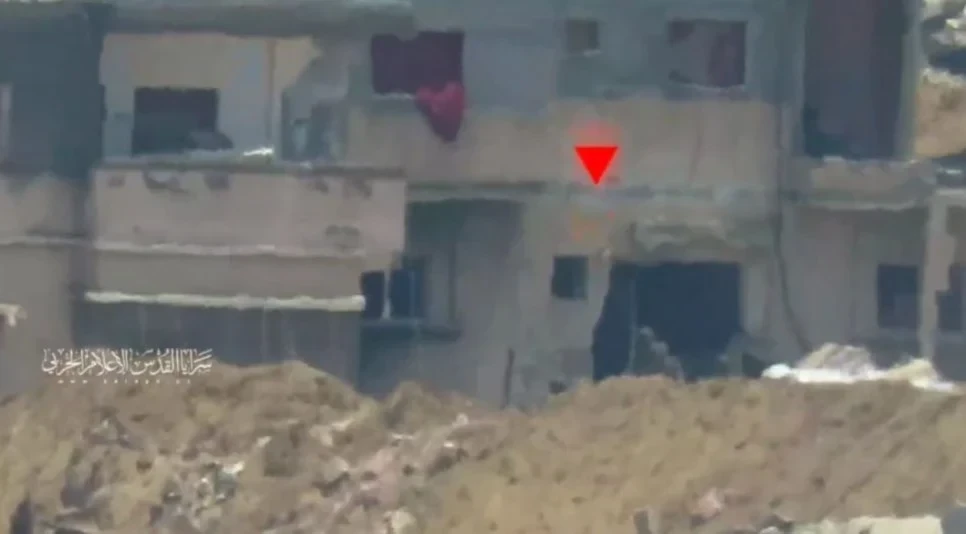Palestinian resistance targets Israeli forces in Khan Younis
Palestinian resistance factions strike Israeli occupation forces in Khan Younis using mortar shells, rockets, and explosive devices amid escalating confrontations in Gaza.
-

A screengrab from a video shared by the al-Quds Brigades Military Media wing showing the targeting of Israeli soldiers in Khan Younes, southern Gaza, August 2, 2025 (Al-Quds Brigades Military Media)
The al-Nasser Salah al-Din Brigades, the military wing of the Popular Resistance Committees, announced on Saturday that its fighters targeted a gathering of Israeli occupation soldiers and military vehicles near the town of Khuzaa, north of Khan Younis in southern Gaza, using 60mm mortar shells.
Simultaneously, the al-Quds Brigades, the armed wing of the Islamic Jihad movement, released footage showing their fighters launching a 107mm rocket at an Israeli command and control site, also north of Khan Younis.
#سرايا_القدس تعرض مشاهد من استهداف مجاهديها مقر قيادة وسيطرة لـ "جيش" الاحتلال بتوجيه صاروخ من نوع (107) شمال مدينة خانيونس.#الميادين pic.twitter.com/90QPZIKEkw
— قناة الميادين (@AlMayadeenNews) August 2, 2025
Two days earlier, the al-Qassam Brigades, the military wing of Hamas, reported targeting a group of Israeli occupation soldiers and vehicles east of the al-Qarara area, in eastern Khan Younis, with multiple mortar shells.
Prior to that, al-Qassam fighters detonated three barrel bombs inside an Israeli occupation vehicle hub south of the al-Batn al-Samin area, also in Khan Younis, resulting in casualties among the soldiers.
These operations come amid continued confrontations across several axes in the Gaza Strip, as resistance factions persist in launching targeted attacks against invading Israeli occupation forces despite relentless bombardment, ongoing attempts at ground incursions, and the suffocating siege on the Strip.
Staggering Israeli losses
Israeli media revealed that the ongoing war on Gaza has cost the Israeli occupation approximately 300 billion shekels (around $80 billion), with analysts suggesting the real figure may have already surpassed that estimate.
Shaul Amsterdamski, economic affairs commentator for the Israeli Kan broadcaster, reported that internal discussions within the occupation’s Ministry of Finance are now focused on the spiraling cost of the war, particularly the military operations component.
Amsterdamski noted that the more the war expands, especially through the occupation of additional territory, the more the costs rise dramatically. The most significant burden, he explained, stems from the prolonged deployment of reserve soldiers, as well as expenses related to ammunition, fuel, and operational logistics.
He added that massive weapons procurement deals, totaling tens of billions, have been made to bolster the Israeli military’s capabilities, warning that these expenditures will have a decade-long financial impact on Tel Aviv's budget.
The economic analyst also cautioned against the occupation’s shifting discourse, where the very concept of "occupation" has been largely ignored. He emphasized that controlling Gaza would entail full administrative responsibility over civilian life, including education, food, sewage, and basic services, in addition to maintaining a large, costly ground force presence.
Defense budget grows into a ‘bottomless pit’
The financial strain is further compounded by the ballooning costs of the Israeli occupation's defense spending. Maariv reports that the 2025 defense budget, recently approved by the Knesset, stands at 135 billion shekels, or 21.8% of the national budget. This includes 75.7 billion shekels in debt repayments to the National Insurance Institute.
The newspaper described both the security establishment and debt servicing as “a bottomless economic pit,” given the continued war-related expenditures.

 3 Min Read
3 Min Read








